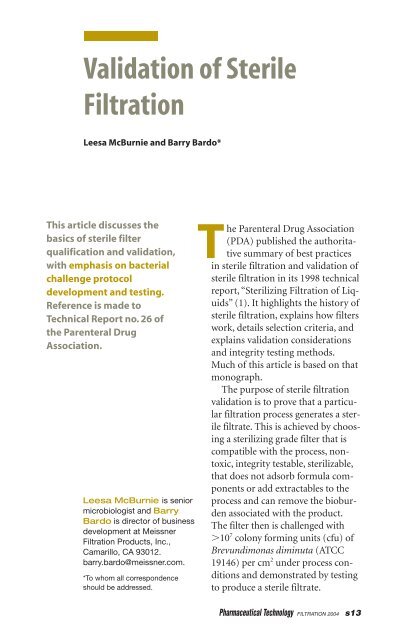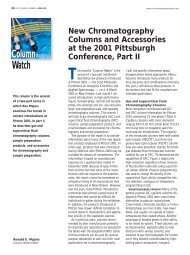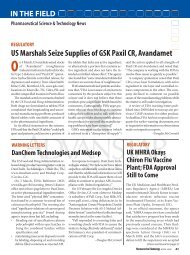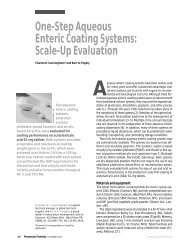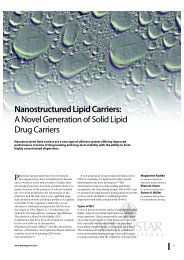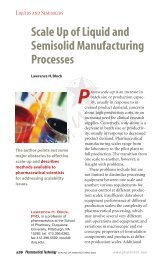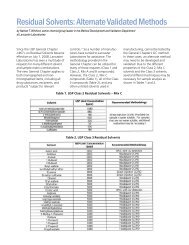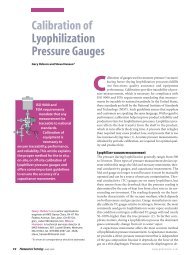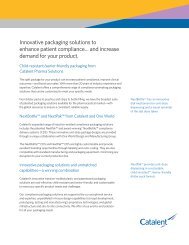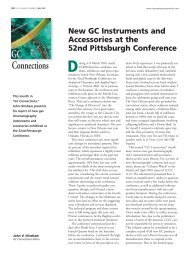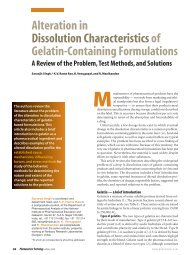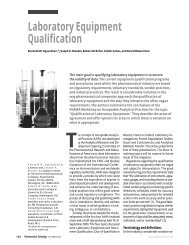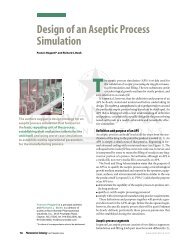Validation of Sterile Filtration - Pharmaceutical Technology
Validation of Sterile Filtration - Pharmaceutical Technology
Validation of Sterile Filtration - Pharmaceutical Technology
You also want an ePaper? Increase the reach of your titles
YUMPU automatically turns print PDFs into web optimized ePapers that Google loves.
<strong>Validation</strong> <strong>of</strong> <strong>Sterile</strong><br />
<strong>Filtration</strong><br />
Leesa McBurnie and Barry Bardo*<br />
This article discusses the<br />
basics <strong>of</strong> sterile filter<br />
qualification and validation,<br />
with emphasis on bacterial<br />
challenge protocol<br />
development and testing.<br />
Reference is made to<br />
Technical Report no. 26 <strong>of</strong><br />
the Parenteral Drug<br />
Association.<br />
Leesa McBurnie is senior<br />
microbiologist and Barry<br />
Bardo is director <strong>of</strong> business<br />
development at Meissner<br />
<strong>Filtration</strong> Products, Inc.,<br />
Camarillo, CA 93012.<br />
barry.bardo@meissner.com.<br />
*To whom all correspondence<br />
should be addressed.<br />
T<br />
he Parenteral Drug Association<br />
(PDA) published the authoritative<br />
summary <strong>of</strong> best practices<br />
in sterile filtration and validation <strong>of</strong><br />
sterile filtration in its 1998 technical<br />
report, “Sterilizing <strong>Filtration</strong> <strong>of</strong> Liquids”<br />
(1). It highlights the history <strong>of</strong><br />
sterile filtration, explains how filters<br />
work, details selection criteria, and<br />
explains validation considerations<br />
and integrity testing methods.<br />
Much <strong>of</strong> this article is based on that<br />
monograph.<br />
The purpose <strong>of</strong> sterile filtration<br />
validation is to prove that a particular<br />
filtration process generates a sterile<br />
filtrate. This is achieved by choosing<br />
a sterilizing grade filter that is<br />
compatible with the process, nontoxic,<br />
integrity testable, sterilizable,<br />
that does not adsorb formula components<br />
or add extractables to the<br />
process and can remove the bioburden<br />
associated with the product.<br />
The filter then is challenged with<br />
10 7 colony forming units (cfu) <strong>of</strong><br />
Brevundimonas diminuta (ATCC<br />
19146) per cm 2 under process conditions<br />
and demonstrated by testing<br />
to produce a sterile filtrate.<br />
<strong>Pharmaceutical</strong> <strong>Technology</strong> FILTRATION 2004 s13
<strong>Filtration</strong><br />
Sterilizing grade filters<br />
The removal rating <strong>of</strong> a given membrane<br />
filter type refers to the size, or<br />
narrower dimension, <strong>of</strong> microorganisms<br />
and particles removed by<br />
the filter, rather than the actual size<br />
or shape (i.e., morphology) <strong>of</strong> the<br />
filter pore structure. The industryaccepted<br />
rating for a sterilizing<br />
grade filter is 0.2 or 0.22 m, depending<br />
on the manufacturer, which<br />
is validated as capable <strong>of</strong> removing<br />
10 7 cfu/cm 2 B. diminuta under<br />
certain extreme processing conditions.<br />
Tighter filters such as 0.1 m<br />
filters that demonstrate the same<br />
bacterial retention also may be rated<br />
as sterilizing grade.<br />
In validating and performing<br />
sterile filtration, it is essential to<br />
identify the bioburden or endemic<br />
microorganism(s) in a given<br />
process, to use the grade <strong>of</strong> filter<br />
that quantitatively removes the microorganism(s),<br />
and to demonstrate<br />
quantitative removal by test before<br />
using the filter in production. This<br />
is the essence <strong>of</strong> filter validation.<br />
For filter manufacturers, a critical<br />
requirement is to provide users with<br />
a reasonably convenient, safe, easyto-perform<br />
integrity test which confirms<br />
the integrity <strong>of</strong> the filter, the<br />
seals, and contiguous process equipment.<br />
Liquid-sterilizing filters can<br />
be integrity tested by the bubble<br />
point, forward flow or diffusion/<br />
diffusive flow test, or the pressure<br />
hold test. Hydrophobic filters can be<br />
tested with any <strong>of</strong> those methods or<br />
by the water intrusion test. Filter integrity<br />
tests are explained in another<br />
article in this issue.<br />
s14 <strong>Pharmaceutical</strong> <strong>Technology</strong> FILTRATION 2004<br />
Qualifying pharmaceutical filters<br />
Safety and purity. Before they can be<br />
used in a sterilizing filtration<br />
process, filters must meet or exceed<br />
minimum safety standards.<br />
The first step is to qualify the filter<br />
in several important areas <strong>of</strong> safety.<br />
To qualify as a pharmaceutical filter,<br />
the filter must be nontoxic, according<br />
to USP-specified tests (e.g., USP 87<br />
“Biological Reactivity Tests,” in vitro,<br />
USP 88 “Biological Reactivity Tests,”<br />
in vitro, USP 88 “Biological Reactivity<br />
Tests,” in vivo, including the Class<br />
VI Plastics Tests) and be tested free <strong>of</strong><br />
pyrogen or endotoxin to acceptably<br />
low levels.<br />
<strong>Pharmaceutical</strong>-grade filters also<br />
must have very low extractables levels,<br />
although neither USP nor the Food<br />
and Drug Administration have specified<br />
minimum or maximum levels. It<br />
is the responsibility <strong>of</strong> pharmaceutical<br />
manufacturers to set allowable specifications<br />
for extractables.<br />
As a further indicator <strong>of</strong> safety<br />
and purity, filters also should rinse<br />
quickly when exposed to highpurity<br />
water, must be compatible<br />
with pharmaceutical process fluids<br />
and pharmaceutical products, and<br />
be both sterilizable and integrity<br />
testable.<br />
All this pharmaceutical filter safety<br />
qualification information typically is<br />
provided in the filter manufacturers’<br />
validation guide and product literature<br />
for a specific filter.<br />
Performance qualification. Filters<br />
must be qualified by the user to<br />
demonstrate that their performance<br />
in processing will meet or exceed<br />
minimum process requirements.<br />
www.pharmtech.com
<strong>Filtration</strong><br />
Performance qualification<br />
requirements<br />
• flow rates<br />
• throughput<br />
• pressure and temperature resistance<br />
• hydrophilic or hydrophobic<br />
• membrane composition<br />
• compatibility<br />
• membrane support layers, core, or cage<br />
• o-rings<br />
• housings<br />
s16 <strong>Pharmaceutical</strong> <strong>Technology</strong> FILTRATION 2004<br />
The filter must be tested to verify<br />
that it provides the flow rates required<br />
by the pharmaceutical<br />
process. The filter system must be<br />
sized to provide flow rates and volumes<br />
adequate to keep pace with<br />
filling machines or other production<br />
equipment requirements, with some<br />
reserve capacity for use in case <strong>of</strong><br />
batch contaminant variability and<br />
premature plugging. The total liquid<br />
volume passed through the filters,<br />
its throughput, should be adequate<br />
to process a complete batch without<br />
interruption.<br />
Small-scale sizing or filterability<br />
tests are used as the basis for extrapolating<br />
or scaling-up filtration systems.<br />
Sizing <strong>of</strong> final, sterilizing filters,<br />
and any upstream prefilters<br />
used to remove coarse contaminants<br />
and thereby extend the life <strong>of</strong> the<br />
final filters, is based upon anticipated<br />
flow rates and throughput in a<br />
given pharmaceutical liquid.<br />
Sterilizing filters and filter housings,<br />
stainless steel, or disposable<br />
plastic, must be rugged enough to<br />
withstand the pressures and temperatures<br />
<strong>of</strong> normal process conditions,<br />
occasional runaway process conditions,<br />
and the temperature ranges <strong>of</strong><br />
processing (minimum to maximum)<br />
and steam or autoclave sterilization,<br />
including both temperature<br />
ranges and duration <strong>of</strong> the sterilization<br />
cycle(s).<br />
Sterilizing-grade filters for aqueous<br />
pharmaceutical liquids are normally<br />
hydrophilic, or waterwettable,<br />
membrane filters. In the<br />
case <strong>of</strong> solvent or chemical liquids<br />
to be filter-sterilized, hydrophobic,<br />
or nonwater-wetting, filters may be<br />
used. They can be wetted by a lowsurface-tension<br />
liquid.<br />
Compatibility. The filter system<br />
must be qualified to ensure that all<br />
product-contact surfaces <strong>of</strong> the filter<br />
and its constituent parts (membrane,<br />
support layers, core, cage,<br />
and end caps), o-rings, piping,<br />
hoses, seals, pumps, gaskets, and any<br />
other components <strong>of</strong> the sterilizing<br />
filtration system can withstand the<br />
hydraulic, thermal, and chemical<br />
challenges <strong>of</strong> the sterilization and<br />
production processes. None <strong>of</strong> these<br />
should extract into the filtered pharmaceutical<br />
product in any significant<br />
amount.<br />
Chemical compatibility questions<br />
generally are resolved by reference<br />
to compatibility tables generated by<br />
manufacturers <strong>of</strong> elastomers or<br />
polymers used in o-rings, gaskets,<br />
and seals. Membrane compatibilities<br />
generally are well established for the<br />
commonly used membrane materials.<br />
Any specific questions can readily<br />
be resolved by testing during the<br />
qualification stage.<br />
www.pharmtech.com
Sterilization <strong>of</strong> sterilizing filters.<br />
Sterilizing grade filters can be sterilized<br />
in a number <strong>of</strong> ways. Capsule<br />
filters can be gamma irradiated or<br />
autoclaved. Disk filter holders are<br />
autoclaved with the wetted filter in<br />
place. Cartridge filter installations<br />
frequently are sterilized by steamin-place<br />
(SIP) operations.<br />
Common steaming temperatures<br />
used in the United States are 121–<br />
135 C, sustained for 30–60 min in<br />
the filter installation. Whatever<br />
time–temperature parameters are<br />
specified, it is critical that these parameters<br />
be validated by the pharmaceutical<br />
manufacturer under operating<br />
conditions.<br />
<strong>Validation</strong><br />
There are four major elements <strong>of</strong><br />
the filtration validation process:<br />
• physical/chemical compatibility,<br />
usually established during the<br />
qualification phase before validation,<br />
is confirmed during the validation<br />
process<br />
• binding and adsorption filter<br />
characteristics are measured in<br />
the qualification phase<br />
• bacteria retention capability <strong>of</strong> the<br />
filter, which is established by challenging<br />
the filter with B. diminuta<br />
• integrity <strong>of</strong> the process filtration<br />
installation, as verified by the filter<br />
integrity test.<br />
Concerning integrity testing, the<br />
user must demonstrate that they<br />
know how to install, sterilize, and<br />
integrity test the filters. Filter integrity<br />
test values provided by the<br />
filter manufacturer are correlated to<br />
the bacterial challenge in the manufacturer’s<br />
validation guide. Product<br />
integrity test values are correlated to<br />
the water or model solvent values.<br />
Bacterial retention. The bacterial<br />
challenge test validates the ability <strong>of</strong><br />
a filter to provide sterile effluent in a<br />
specific pharmaceutical liquid. It is<br />
also the ultimate compatibility test,<br />
because the bacterial challenge simultaneously<br />
tests the physicalchemical<br />
interaction <strong>of</strong> the liquid<br />
product and the filter, under process<br />
conditions. Any filter inadequacy<br />
caused by this interaction will be<br />
detected by the bacterial challenge.<br />
<strong>Validation</strong> <strong>of</strong> bacterial retention<br />
normally is performed by the filter<br />
manufacturer or an independent laboratory,<br />
using 47-mm diameter disks<br />
to minimize the volume <strong>of</strong> pharmaceutical<br />
product required. Larger surface<br />
area filters also can be used.<br />
Bacterial challenge tests are usually<br />
performed with an industry<br />
standard concentration <strong>of</strong> 10 7 cfu <strong>of</strong><br />
B. diminuta per cm 2 , using pharmaceutical<br />
product, whenever possible,<br />
for the most realistic validation. The<br />
high bacterial concentration used in<br />
the challenge test constitutes a<br />
worst-case scenario. The manufacturer<br />
qualifies the filter using a similar<br />
challenge.<br />
B. diminuta is grown to produce<br />
monodispersed cells capable <strong>of</strong> penetrating<br />
a 0.45-m filter, typically in<br />
accordance with ASTM Standard<br />
F838. Following that standard, the<br />
organism is cultured in saline lactose<br />
broth (SLB) and either used<br />
freshly cultured or concentrated<br />
into a frozen cell paste that is<br />
thawed immediately prior to use. A<br />
<strong>Pharmaceutical</strong> <strong>Technology</strong> FILTRATION 2004 s17
<strong>Filtration</strong><br />
0.4-µm rated membrane filter is<br />
used as a positive control; if the organisms<br />
pass through this control<br />
filter, it proves that they are alive,<br />
small, and nonaggregated, thus verifying<br />
that the challenge is a stringent<br />
test.<br />
<strong>Validation</strong> parameters for bacterial<br />
challenge using pharmaceutical product.<br />
Key considerations for using<br />
pharmaceutical product liquid to<br />
validate sterile filters are listed in the<br />
following chart.<br />
Product contact time.The bacterial<br />
challenge using pharmaceutical<br />
product must be run for at least the<br />
same duration as a product batch<br />
will be run in processing. If the<br />
batch requires eight hours to filter,<br />
the challenge must be run for at<br />
least eight hours. It is good practice<br />
to run the challenge for a little<br />
longer to anticipate unusual processing<br />
circumstances.<br />
Differential pressure and flow rates per unit<br />
area. Maximum process differential<br />
pressures and flow rates should be<br />
incorporated into the protocol.<br />
Often, it is virtually impossible to<br />
match both simultaneously. At the<br />
start <strong>of</strong> the challenge, when the filter<br />
is clean, extremely high flow rates<br />
per unit area are necessary to generate<br />
process-level differential pressures<br />
(pressure drop across the filter).<br />
But, as the test filter disks<br />
accumulate bacteria and pressure<br />
builds, the flow drops. One solution<br />
is to match flow rates at the start <strong>of</strong><br />
the challenge and pressures near the<br />
end. Another solution is to decide<br />
whether pressure or flow is more relevant,<br />
and then develop a technically<br />
s18 <strong>Pharmaceutical</strong> <strong>Technology</strong> FILTRATION 2004<br />
<strong>Validation</strong> parameters<br />
• product contact time<br />
• differential pressure<br />
• flow rates per unit area<br />
• temperature<br />
• bioburden<br />
• integrity test correlation<br />
sound rationale to support the decision<br />
and use it in challenge testing.<br />
Temperature.If the liquid temperature<br />
is outside the viable range <strong>of</strong><br />
the challenge bacteria, it may be<br />
necessary to recirculate the product<br />
at process temperature, conditioning<br />
the filter first, and then challenge<br />
the filter at a temperature at<br />
which the bacteria survive.<br />
Bioburden. Bioburden levels can influence<br />
process filtration efficacy.<br />
The probability <strong>of</strong> passage increases<br />
when the bioburden is high. The<br />
area-specific bioload (B a ) is the<br />
bioburden per unit area <strong>of</strong> filter<br />
(cfu/cm 2 ) or B a = BV/A, where B is<br />
the bioburden in cfu/mL, V is the<br />
total volume to be filtered (mL) and<br />
A is the surface area <strong>of</strong> the filter in<br />
cm 2 . It is therefore best to control<br />
the bioburden <strong>of</strong> the raw materials<br />
to avoid approaching or exceeding<br />
the validated limit.<br />
Integrity test correlation.Filters used in<br />
the bacterial challenge must be integrity<br />
tested to form the correlation<br />
to retention. Because the user cannot<br />
use a destructive challenge test<br />
in processing, the filter manufacturer<br />
must supply a correlated, nondestructive<br />
integrity test that reliably<br />
assesses the integrity <strong>of</strong> a given<br />
filter installation. In performing the<br />
www.pharmtech.com
Select filter<br />
Filter extractable<br />
validation<br />
Microbial retentivity<br />
validation<br />
Physical parameters<br />
validation<br />
Determine and document<br />
viability <strong>of</strong> B. diminuta<br />
in product under<br />
process conditions<br />
Develop nonbactericidal<br />
surrogate with same product<br />
characteristics for toxic,<br />
high abuse potential<br />
or limited supply drugs<br />
B. diminuta viable in<br />
product under process<br />
conditions<br />
Direct inoculation <strong>of</strong><br />
B. diminuta into product<br />
under process conditions<br />
B. diminuta not viable<br />
in product under process<br />
conditions<br />
Precondition filter with product–<br />
followed by microbial challenge.<br />
One or a combination <strong>of</strong> the following<br />
methods may possibly be used<br />
Modify process–<br />
adjust temperature, etc.<br />
Modify formulation–<br />
adjust pH, remove<br />
bactericidal component<br />
product surrogate<br />
Use product for<br />
time period challenge<br />
organism is viable<br />
Change from B. diminuta–<br />
use bacteria isolated from<br />
formulation or environment<br />
Figure 1: Establishing a microbial challenge protocol (1).<br />
challenge test, three lots <strong>of</strong> filters<br />
typically are chosen, including a<br />
low-bubble-point lot, one with a<br />
bubble point specification that approximates<br />
the manufacturer’s production<br />
limit. This is important because<br />
the end user is limited to<br />
using filters in their process that<br />
match or exceed the lowest bubble<br />
point validated in product.<br />
Establishing the challenge protocol.<br />
The above chart highlights the steps<br />
needed to develop a suitable challenge<br />
protocol.<br />
After the filter is qualified and selected,<br />
filter extractables and microbial<br />
retentivity are validated. Physical<br />
parameters such as sterilization<br />
and integrity test methods also are<br />
validated. Viability <strong>of</strong> the test microorganism,<br />
B. diminuta, in the<br />
pharmaceutical product is compared<br />
to a control over time. If there is less<br />
than one log difference in the counts,<br />
the organism is considered viable<br />
under those conditions. Results are<br />
documented. If a pharmaceutical<br />
product is toxic, has high potential<br />
for abuse, or is in limited supply, a<br />
nonbactericidal surrogate fluid with<br />
very similar properties may be developed.<br />
It is recommended that the<br />
user consult with local FDA inspectors<br />
before developing this approach.<br />
If the microbe is viable. If B. diminuta<br />
is found to be viable in the pharmaceutical<br />
product, it is directly inoculated<br />
into the product as the challenge<br />
microorganism.<br />
If the microbe is nonviable. If B. diminuta<br />
is found to be nonviable under<br />
process conditions, the test filter is<br />
<strong>Pharmaceutical</strong> <strong>Technology</strong> FILTRATION 2004 s19
<strong>Filtration</strong><br />
Factors affecting microbial<br />
retention<br />
• filter type: polymer, structure<br />
• fluid properties: pH, viscosity, osmolarity,<br />
and ionic strength<br />
• process conditions: temperature, differential<br />
pressure, and flow rate<br />
• bioburden: quantity, composition<br />
preconditioned with pharmaceutical<br />
product liquid, and one <strong>of</strong> several<br />
options can be followed, prior to<br />
conducting the bacterial challenge.<br />
Options are to:<br />
• modify the process by adjusting<br />
temperature or otherwise<br />
• modify the formulation, by adjusting<br />
pH, removing bactericidal<br />
components, or using a product<br />
surrogate liquid<br />
• use the bacteria for a brief enough<br />
time such that the challenge microorganism<br />
retains its viability during<br />
the test period<br />
• switch the test organism from B.<br />
diminuta to a process isolate, or native<br />
bioburden endemic to the actual<br />
pharmaceutical process. It is<br />
recommended to consult first with<br />
FDA inspectors on this option.<br />
If the product is bactericidal, the<br />
volume and time required to thoroughly<br />
rinse the filter free <strong>of</strong> the<br />
product must be established, after<br />
the product has been recirculated,<br />
prior to adding the bacteria and<br />
challenge solution. This is documented<br />
in an inhibition test.<br />
Bacterial challenge. The challenge<br />
procedure typically consists <strong>of</strong> integrity<br />
testing the filters, autoclaving<br />
s20 <strong>Pharmaceutical</strong> <strong>Technology</strong> FILTRATION 2004<br />
the apparatus, integrity testing poststerilization<br />
and recirculating product<br />
through the filters at process<br />
flow rates or pressures. Bacteria are<br />
added according to the results <strong>of</strong> the<br />
viability study. In nonbactericidal<br />
products, the microorganisms are<br />
added at intervals throughout the<br />
challenge. Before introducing the<br />
bacteria, analysis membranes are installed<br />
downstream <strong>of</strong> all test and<br />
control filters. Analysis filters must<br />
have a pore size <strong>of</strong> at least 0.45 m<br />
or tighter. Membranes that are 0.45<br />
m will retain 10 4 –10 6 logs <strong>of</strong> Brevundimonas,<br />
which generally is accepted<br />
as adequate for a valid test.<br />
Bracketing<br />
• challenge extreme products<br />
• carefully choose family groupings<br />
• API concentration levels<br />
• pH, other<br />
• validates intermediate products<br />
Factors affecting bacterial retention.<br />
The bacterial challenge procedure<br />
addresses the possible influences<br />
upon retention <strong>of</strong> the membrane<br />
polymer, liquid, process conditions,<br />
and bioburden level. Adverse effects<br />
from any <strong>of</strong> these parameters would<br />
result in bacterial passage.<br />
The only factor not routinely addressed<br />
in the filter validation or<br />
microbial challenge process is composition<br />
<strong>of</strong> the bioburden. Composition<br />
<strong>of</strong> bioburden should be addressed<br />
prior to choosing the<br />
removal rating <strong>of</strong> the filter, during<br />
filter qualification.<br />
Bracketing.It is not always necessary<br />
www.pharmtech.com
to perform a microbial challenge<br />
on every pharmaceutical<br />
product. The practice <strong>of</strong><br />
bracketing makes this acceptable.<br />
With a family <strong>of</strong><br />
pharmaceutical products<br />
having high degrees <strong>of</strong> similarity<br />
but only slightly differing<br />
characteristics such as<br />
differing concentrations <strong>of</strong><br />
active ingredient, we can<br />
perform the microbial challenge<br />
on the extreme products<br />
(i.e., those having the<br />
highest and lowest concentrations)<br />
while products<br />
with intermediate-level concentrations<br />
need not be individually<br />
challenge-tested.<br />
However, we must generate data to<br />
show that these product extremes<br />
have been tested.<br />
Extractables.Another important aspect<br />
<strong>of</strong> sterile filter validation is extractables<br />
testing. It is important<br />
that the filters are not themselves a<br />
source <strong>of</strong> physical (e.g., particles) or<br />
chemical contaminants.<br />
Adsorption analysis<br />
• binding <strong>of</strong> formulation components to filter<br />
• potential for OOS ingredients<br />
• identify any problem<br />
• address problem if necessary<br />
Figure 2: Bacterial challenge test apparatus<br />
showing differential pressure between two inline<br />
47-mm diameter filter disk holders in series, with<br />
the challenge filter upstream and the analysis filter<br />
downstream, connected by sanitary piping to a<br />
peristaltic pump which recirculates the challenge<br />
microorganism.<br />
The nonvolatile residue (NVR)<br />
test from USP 661 Containers is<br />
used to quantify the amount <strong>of</strong> extractables<br />
released by a filter in a<br />
particular process stream. NVR typically<br />
is tested by using a model solvent,<br />
rather than pharmaceutical<br />
product. It involves soaking the filter,<br />
boiling <strong>of</strong>f the solvent, drying<br />
the residue, and weighing it. The<br />
weight <strong>of</strong> residue per filter is calculated.<br />
<strong>Pharmaceutical</strong> products seldomly<br />
are used for NVR assay, because<br />
their constituents mask filter<br />
extractables. Various analytical techniques<br />
may be applied to identify<br />
filter extractables.<br />
Adsorption.The flip side <strong>of</strong> the phenomenon<br />
<strong>of</strong> filter extractables is the<br />
phenomenon <strong>of</strong> filter adsorption.<br />
The filter should not remove active<br />
ingredients, excipients, carriers, diluents,<br />
proteins, preservatives, or any<br />
other formulation component. It is<br />
important to test the product to ensure<br />
that the filter does not cause any<br />
ingredient to fall below specification.<br />
With most sterilizing grade filters,<br />
adsorptive levels are so low as to be<br />
insignificant and well within limits<br />
<strong>Pharmaceutical</strong> <strong>Technology</strong> FILTRATION 2004 s21
<strong>Filtration</strong><br />
Table I: Tests commonly performed by filter users and the filter<br />
manufactures–general industry practices.<br />
Filter user Filter manufacturer<br />
Criteria Filter device Membrane disk Device<br />
Bacteria retention/integrity — Q Q<br />
test relationship data<br />
Integrity test<br />
water/solvent V Q, R, L Q, R, L<br />
product V — —<br />
Integrity test methodology V R —<br />
and selection<br />
Bacterial retention<br />
water, SLB, etc. — Q, L Q, L<br />
product V, membrane disk — —<br />
Bacterial retention/integrity V Q Q<br />
test methodology<br />
Effects <strong>of</strong> chemical compat- V Q Q<br />
ibility on filter integrity<br />
Toxicity testing — Q Q<br />
Extractables V Q, R, L Q, R, L<br />
Effects <strong>of</strong> sterilization V Q Q<br />
methods on filter integrity<br />
Q denotes qualification testing process specific; V denotes validation testing; R<br />
denotes recommendation for validation; and L denotes filter lot specific release<br />
criteria.<br />
set by pharmaceutical manufacturers.<br />
However, if an adsorption problem<br />
is experienced with a certain<br />
formulation, it should be addressed.<br />
Redundant filtration. One final circumstance<br />
to be addressed in validation<br />
is the use <strong>of</strong> redundant filters,<br />
two final filters <strong>of</strong> identical<br />
rating deployed in series as “insurance”<br />
against nonsterile filtration.<br />
This practice is common in Europe<br />
and with some American manufacturers<br />
<strong>of</strong> serum, tissue culture<br />
media, and biologicals.<br />
If both filters are needed to<br />
achieve sterility in a given process,<br />
s22 <strong>Pharmaceutical</strong> <strong>Technology</strong> FILTRATION 2004<br />
both must pass the post-use integrity<br />
test in process operations. If<br />
only one filter in the series is necessary<br />
to validate a sterile filtrate, then<br />
only one is required to pass the integrity<br />
test.<br />
Where redundant filters are installed,<br />
the validation process also<br />
must address the impact <strong>of</strong> the second<br />
filter on extractables levels and<br />
adsorption (i.e., twice as much).<br />
PDA Technical Report No. 26<br />
Filter validation recommendations.<br />
PDA’s Technical Report No. 26 summarizes<br />
the principles and best<br />
www.pharmtech.com
practices <strong>of</strong> sterile filtration and its<br />
validation. In this article, we have<br />
described details <strong>of</strong> some <strong>of</strong> the<br />
more significant aspects <strong>of</strong> filter validation<br />
that follow the recommendations<br />
<strong>of</strong> “TR26.”<br />
TR26 recommends that the pharmaceutical<br />
manufacturer perform a<br />
process-specific validation which<br />
includes:<br />
• establishing an integrity test<br />
methodology and demonstrating<br />
integrity <strong>of</strong> the sterilizing filter<br />
• performing bacterial retention<br />
studies<br />
• having a correlation between bacterial<br />
retention and the integrity test<br />
method<br />
• verifying chemical compatibility<br />
• performing extractables testing<br />
• evaluating the effects <strong>of</strong> sterilization<br />
on filter integrity.<br />
Summary and conclusion<br />
The validation report summarizes<br />
the protocols, results, and interpretations<br />
<strong>of</strong> all testing performed. It<br />
also provides parameters and protocols<br />
for performing steam or autoclave<br />
sterilization and integrity testing.<br />
The report is an important<br />
documentation <strong>of</strong> the validation<br />
process. It should be read and understood<br />
by all end users involved in<br />
validating the specific sterile filtration<br />
process. The report also serves<br />
as an important reference document<br />
in an FDA inspection.<br />
While filter manufacturers perform<br />
much <strong>of</strong> the qualification and<br />
validation work in sterile filtration<br />
validation, it is crucial for the pharmaceutical<br />
processor to remember<br />
that the pharmaceutical or biopharmaceutical<br />
company bears complete<br />
responsibility for:<br />
• filter validation<br />
• use <strong>of</strong> the validated sterile filtration<br />
system in compliance with current<br />
good manufacturing processes<br />
and the recommendations <strong>of</strong> the<br />
filter manufacturer as found in the<br />
validation report and supporting<br />
documentation.<br />
<strong>Pharmaceutical</strong> users <strong>of</strong> sterile filtration<br />
are urged to read PDA’s<br />
Technical Report No. 26, to follow<br />
its guidelines, and to work closely<br />
with their filtration manufacturer<br />
in resolving any questions or issues<br />
relating to sterile filtration and its<br />
validation.<br />
References<br />
1. PDA Technical Report #26, “Sterilizing<br />
<strong>Filtration</strong> <strong>of</strong> Liquids,” J.Pharm. Sci. and<br />
Technol. 52 (1 Supp) (1998).<br />
2. T.H. Meltzer, ed., <strong>Filtration</strong> in the <strong>Pharmaceutical</strong><br />
Industry (Marcel Dekker, Inc.,<br />
New York, NY, 1987).<br />
3. American Society for Testing and Materials<br />
(ASTM), Standard Test Method<br />
for Determining Bacterial Retention <strong>of</strong><br />
Membrane Filters Utilized for Liquid <strong>Filtration</strong>,<br />
ASTM Standard F838-83,<br />
(ASTM, Philadelphia, PA, 1983).<br />
4. P. Stinavage, “Perspective on <strong>Filtration</strong>”<br />
presented at PDA, Washington DC, 3<br />
December 1999. PT<br />
<strong>Pharmaceutical</strong> <strong>Technology</strong> FILTRATION 2004 s23


